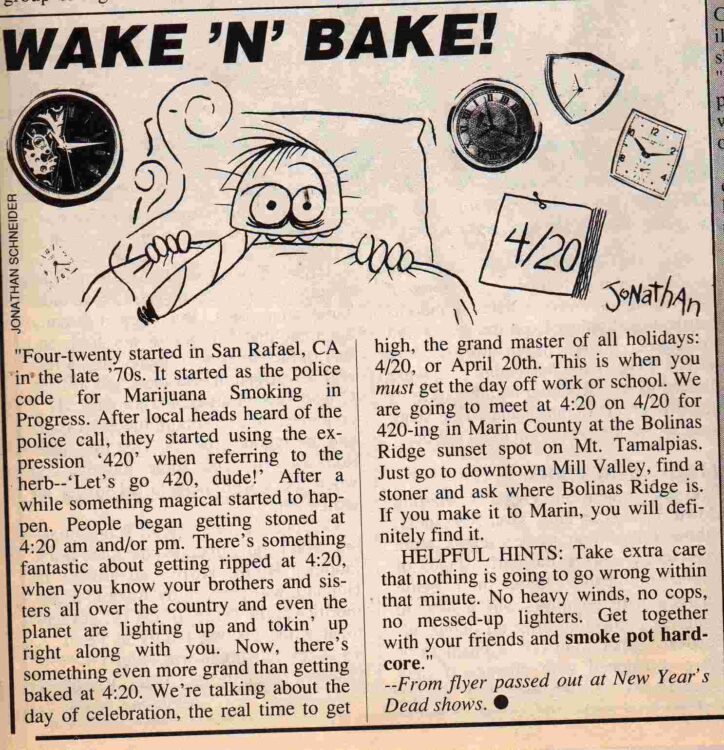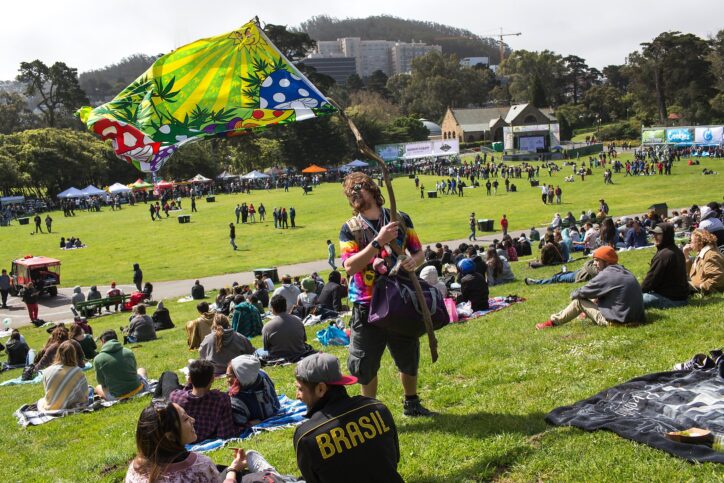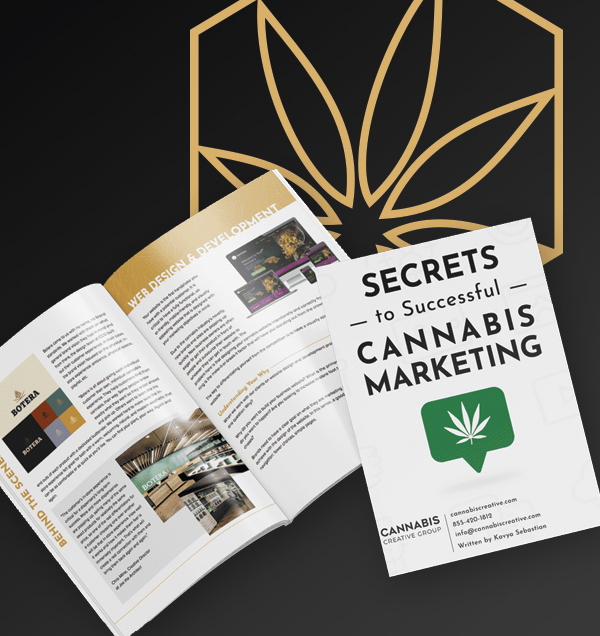There is one day each year that brings an entire community together to celebrate the culture of the cannabis plant.
April 20th, or 4/20, is an occasion for smoking and celebrating the many wonders of cannabis! The number ‘420’ and this specific date have a significant impact on cannabis and have shaped the culture we know today.
Legendary myths around the holiday and ‘420’ term have been passed around like a joint at a Friday night smoke session.
The truth is, one group of stoner friends changed it all.
We’re clearing the smoke on the history of 420 and spotlighting how its impacted today’s legal market and industry across the U.S.
How did one term create an entire cannabis culture?
There’s been several different names given to cannabis throughout the years – Mary Jane, ganja, bud, marijuana, weed, bhang, grass, reefer, and just about any other slang you can think of.
However, the term ‘420’ has made a widespread and significant impact on an entire culture, community, and industry.
Long before states legalized cannabis or before brands introduced innovative products to the market – novice consumers and cannasseurs alike all knew the ‘420’ term to be associated with weed. Rappers and rock musicians would sing it out in songs, and comedy movies and television shows have created 420-related storylines and plots.
Over the years, there’s been a few legendary myths and tall tales on how exactly the ‘420’ term made its way into mainstream society.
- In the song “Rainy Day Women #12 & 35,” Bob Dylan sings, “Everybody must get stoned…” which many believed to have been a strong reference to this term. (Especially considering that when you multiply 12 x 35, you get 420).
- Some suggested the term came from the number of chemical compounds in cannabis, but scientists have now proven that cannabis contains well over 500 different compounds.
- One theory suggested ‘420’ was a police radio code referring to its illegal use. Although neither the LAPD nor NYPD uses the term, this myth isn’t too far off from the real truth.
While the 420’s origin is still a bit hazy, there is one reality that seems to be the term’s true evolution and history.
It all started with a group of friends after school.
Each day once the final school bell rang, this group would meet up to sneak in a smoke session behind the San Rafael High School building wall. Their name? The Waldos.
One day in 1971, rumors swirled around about a California Coast Guard who had grown a cannabis plant somewhere hidden in the San Rafael forest. Adventuring off to his next assignment, the Coast Guard left a map behind for the Waldos to track down this secret, hidden plant.
The group immediately initiated the challenge of finding the cannabis plant – they planned to meet up each day after their extracurricular activities to search the forest. The meet-up time for this scavenger hunt was exactly 4:20pm.
Throughout the weeks of searching, the Waldos would pass by each other in the hallway and whisper the secret code “Louis-4:20” to specify where and when to meet after school.
“We got tired of the Friday night football scene with all of the jocks. We were the guys sitting under the stands smoking a doobie, wondering what we were doing there,” Dave Reddix, a member of the friend group recalled in a Time interview a few decades later.
Today, the Waldos friend group – Steve Capper, Dave Reddix, Jeffrey Noel, Larry Schwartz, and Mark Gravich — are all still friends.

They bonded greatly over the scavenger hunt together and recalled their adventures each time they met for a smoke session. Although they never found this mysterious cannabis plant in the ‘70s, the term stuck within the friend group and beyond.
Little did they know, their ‘420 code’ would launch an entire culture and community!
Curating a 420 culture for all
Fast forward a few years later, the Waldos all found themselves individually connected with the ’70s hippie scene. Dave Reddix from the Waldos landed a roadie gig with the iconic jam band the Grateful Dead, who quickly popularized the term among the group.
“We’d always be backstage running around or on stage and, of course, we’re using those phrases. When somebody passes a joint or something, ‘Hey, 420.’ So it started spreading through that community,” Dave Reddix and Steve Capper told the Huffington Post.
By December 1990, a group of ‘Deadhead’ fans in Oakland, California were passing out flyers inviting people to smoke “420” on April 20th at 4:20pm. This flyer got into the hands of Steve Bloom, a writer for High Times magazine at the time.

In the late ‘90s, the Waldos were interviewed by High Times are revealed the truth behind their 420 code and how their inside joke became a cultural phenomenon.
Between the flyer shared in this High Times publication and the ‘420’ term passed around by Grateful Dead fans – the ultimate storm in cannabis culture was born.
A worldwide celebration
Since the emergence of legalization and states with newer markets, the 420 holiday today is now larger than ever.
Exciting popups and entertaining events occur in honor of bringing people together for the day. Furthermore, unofficial, official meetups that were once the place to meet on April 20th have now grown into large sponsored 420 events across the country – such as the iconic Hippie Hill on 4/20 in Golden Gate Park, San Francisco.

In Massachusetts alone, there are dozens of concerts, festivals, and dispensary events going on throughout the entire 4/20 week this year!
Holiday deals & dispensary discounts
In addition to the plethora of celebratory events held each year on this holiday, cannabis brands and recreational dispensaries offer exciting shopping deals to ring in the 420 holiday season.
Each year during the day of 4/20, recreational dispensaries and cannabis retailers see a considerable increase in overall sales. Last year was no different, marking it the biggest sales day of the entire year.
- Overall last year, the average U.S. cannabis dispensary experienced a 148% increase in sales.
- Per dispensary location, the average sales revenue increased by 8%. This dispensary revenue was twice higher than the average Saturday, typically the busiest day for dispensaries.
- 71% of all 420 dispensary transactions included a discount in 2022. Sales data from Colorado showed that April 16th-20th, 2021 saw the lowest average retail prices but the highest daily dollar sales.
This year, cannabis dispensaries and legal states are preparing for another huge uptick in sales for the 420 holiday. Cannabis research group BDSA has projected this year’s 420 sales to increase by 14% (with a predicted $59.6 billion market size by 2027).
The unofficial, official holiday has undoubtedly made a splash in the legal U.S. market and sales each year. This upcoming 420, dispensary owners will implement sales strategies and business plans designed to prepare and market for the largest dispensary sales day of the year.
Celebrating 420 Culture with Cannabis Creative
The 420 origins have proven a hazy history can make a clear and influential impact on today’s society and pop culture.
This yearly 4/20 date has had a strong influence on dispensary sales and revenue in the past. With that in mind, it’s important to have your cannabis brand or dispensary promote and market how you celebrate!
Cannabis Creative is here to help you ring in the 420 holiday with our cannabis marketing expertise.
- Promote your various 420 dispensary deals by targeting specific audiences and locations in pay-per-click advertising.
- Implement a local cannabis SEO strategy on your business’ website to drive traffic to your online dispensary menu.
- Create attention-grabbing content that shows your followers you’re ready to celebrate!
Plus, check out our marketing agency’s Instagram to enter our annual 4/20 giveaway!
No matter how you celebrate 420 this year, remember it’s a time for the community to come together to honor, celebrate, and appreciate the plant!
Contact us to learn more about our cannabis marketing agency & services. Read our Blog for the latest on marketing in the cannabis industry, or sign up for our newsletter for more!
